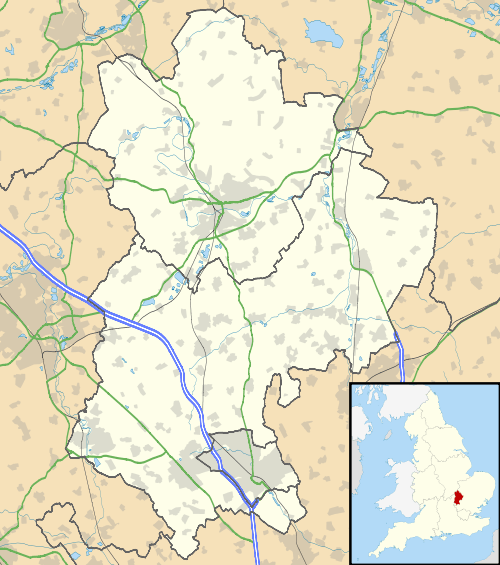Harlington, Bedfordshire
| Harlington | |
Mar2005.jpg) Harlington Crossroads |
|
 Harlington |
|
| Population | 2,260 (2004) 2,297 (2011 Census)[1] |
|---|---|
| OS grid reference | TL035305 |
| Civil parish | Harlington |
| Unitary authority | Central Bedfordshire |
| Ceremonial county | Bedfordshire |
| Region | East |
| Country | England |
| Sovereign state | United Kingdom |
| Post town | DUNSTABLE |
| Postcode district | LU5 |
| Dialling code | 01582, 01525 |
| Police | Bedfordshire |
| Fire | Bedfordshire and Luton |
| Ambulance | East of England |
| EU Parliament | East of England |
| UK Parliament | Mid Bedfordshire |
|
|
Coordinates: 51°57′48″N 0°29′42″W / 51.963355°N 0.495006°W
Harlington is a village and civil parish located in Bedfordshire, England, near the M1 motorway. The nearest town is Flitwick about three miles to the north.
Transport links
Road
The village is about 1.5 miles from junction 12 of the M1, 7 miles (11 km) north of Luton, 10 miles (16 km) south of Bedford and 40 miles NNW of London.
Rail
Harlington has a railway station in the west of the village. It was built by the Midland Railway in 1868 on its extension to St. Pancras. The original intention had been to call it "Harlington for Toddington". The station is served by Thameslink route trains. From Harlington station, you can travel north to Flitwick and Bedford, or south to Luton, Luton Airport Parkway, Harpenden, St Albans, Central London, East Croydon, Gatwick Airport and Brighton.
Buses
The X42 service provides a direct link to Toddington, Westoning, Flitwick, Ampthill, Houghton Conquest, Kempston, and Bedford.
Air
The nearest airport is at Luton, about 8 miles to the South.
Amenities
Harlington has two public houses, the Carpenters Arms[2] and The Old Sun.[3][4] There are several churches, including the Church of St Mary the Virgin, Harlington Methodist Church and Life Church (part of the Pioneer network of churches). There is a small parade of shops consisting of a general store with post office counter, a hairdresser, a cafe and a gunsmiths. Other businesses include an estate agent in Church Road.
There are several buildings surrounding the village green used for community activities. These include the parish hall, village hall and scout hut. A cricket pitch adjoins the village green.
Schools
The village is home to Harlington Lower and Upper Schools which serve students up to A-level. Many students from the surrounding Luton and Bedfordshire area travel to Harlington for its schools. Harlington Upper School recently became a specialist science college, thanks to funding raised by its Parent-Teacher Association, HUSA.[5]
The village also has Harlington Lower School, which has an age range from reception class through to age 9 and received a "Outstanding"[6] rating in its 2010 OFSTED report. As Bedfordshire is a three tier schools system, most children in the middle age bracket spend their middle years at Parkfields in nearby Toddington.
Also on the Lower School site is Harlington Village Pre-School,[7] a volunteer run charity accepting children from the ages of two years and nine months.
History
- 1086: The Domesday book calls the village Herlingdone[8] and lists Nigel D'Albini as Lord of the Manor; he took over from four Saxon thegns who lost their lands at the time of the Norman Conquest in 1066.[9]
- 1300–1350: The Church of St Mary the Virgin was built, replacing what was probably a wooden church with a thatched roof.[8] The church tower was not added until the fifteenth century.[9]
- 1349: Over a quarter of the village died of the Black Death.[9]
- 1660: John Bunyan led an unauthorised religious meeting at a farmhouse near Harlington, for which he was arrested and taken to Harlington House (now known as Harlington Manor-the only currently occupied residential house connected with Bunyan). After being questioned he was imprisoned for twelve years in Bedford county gaol. While serving his sentence he began writing his most famous work, The Pilgrim's Progress.[10]
- 1830: the first English National Steeplechase on record was run from Bury Orchard to Wrest Park Obelisk.[9]
- 1859: the first village school was built.[9]
- 1868: Harlington railway station opened.[9]
- 1920: Harlington War Memorial dedicated to the memory of 27 Harlington men killed in the First World War.[9]
- 1937: Sir Albert Richardson designs a new North range of Harlington Manor
See also
References
- ↑ "Civil Parish population 2011". Neighbourhood Statistics. Office for National Statistics. Retrieved 8 November 2016.
- ↑ "The Carpenters Arms Harlington". Retrieved 29 August 2010.
- ↑ "The Old Sun Harlington". Retrieved 20 August 2010.
- ↑ "Places to Drink in Bedfordshire". informationBritain. Retrieved 19 August 2006.
- ↑ "Harlington Upper School". 2006. Retrieved 19 August 2006.
- ↑ Harlington Lower School
- ↑ "Harlington Village Pre-School". Retrieved 20 March 2013.
- 1 2 Harlington Church (2006). "A brief history of St Mary's". Retrieved 19 August 2006.
- 1 2 3 4 5 6 7 "Harlington Timeline". Besfordshire Libraries. 2005. Retrieved 19 August 2006.
- ↑ "Harlington Tourist Information". AboutBritain.com. 2006. Retrieved 19 August 2006.
External links
| Wikimedia Commons has media related to Harlington, Bedfordshire. |
- Harlington Heritage Trust
- Harlington: historical and genealogical information at GENUKI.
- Harlington Church
- Harlington.net (village diary)
- Harlington Cricket Club
- Harlington Manor